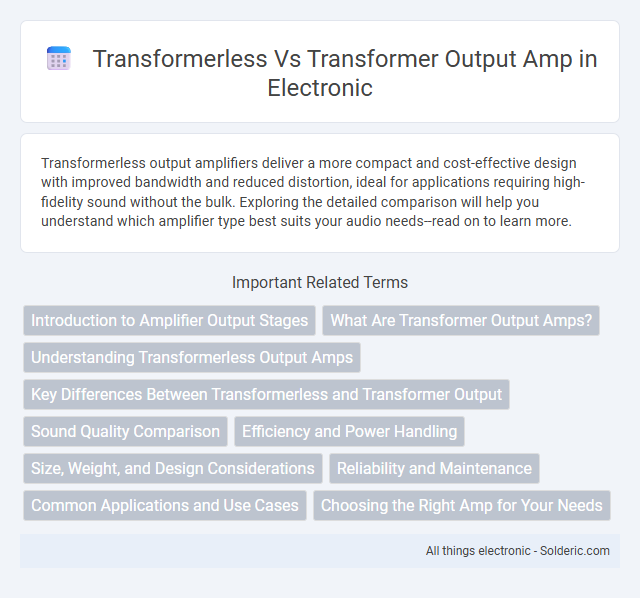Transformerless output amplifiers deliver a more compact and cost-effective design with improved bandwidth and reduced distortion, ideal for applications requiring high-fidelity sound without the bulk. Exploring the detailed comparison will help you understand which amplifier type best suits your audio needs--read on to learn more.
Comparison Table
| Feature | Transformerless Output Amplifier | Transformer Output Amplifier |
|---|---|---|
| Design Complexity | Simple, compact, fewer components | Complex, bulky, requires transformer integration |
| Power Efficiency | Higher efficiency, less power loss | Lower efficiency due to transformer losses |
| Frequency Response | Wide bandwidth, flat frequency response | Limited by transformer characteristics, possible roll-off |
| Impedance Matching | Requires additional circuitry | Transformer provides inherent impedance matching |
| Cost | Lower cost, fewer materials | Higher cost due to transformer manufacturing |
| Distortion | Potentially higher distortion at high power | Generally lower distortion with proper transformer |
| Size & Weight | Smaller, lighter | Larger, heavier due to transformer |
| Reliability | More reliable, fewer failure points | Potential transformer failure, magnetic saturation issues |
Introduction to Amplifier Output Stages
Amplifier output stages either employ transformer coupling or operate transformerless, significantly impacting sound quality and efficiency. Transformer output amps isolate the load and provide impedance matching, which enhances signal stability especially in tube amplifiers. Transformerless output stages use direct coupling for improved frequency response and reduced distortion, commonly found in modern solid-state amplifiers.
What Are Transformer Output Amps?
Transformer output amps use electromagnetic transformers to match impedance between the amplifier and speakers, enhancing sound quality and power transfer efficiency. Transformerless output amps rely on solid-state components like transistors or MOSFETs to directly drive speakers without transformers, leading to a more compact design and typically lower distortion at high frequencies. Your choice depends on desired audio characteristics, with transformer amps offering classic warmth and transformerless amps providing precise modern performance.
Understanding Transformerless Output Amps
Transformerless output amplifiers offer a direct coupling between the amplifier and the load, resulting in improved frequency response and reduced distortion compared to transformer-coupled designs. These amps eliminate bulky, heavy transformers, enhancing efficiency and reducing cost while maintaining high power output and sound fidelity. Understanding their operation involves recognizing the benefits of direct current conduction and low impedance output stages that provide better transient response and broader bandwidth.
Key Differences Between Transformerless and Transformer Output
Transformerless amplifiers rely on solid-state components like transistors and capacitors to directly drive the load, resulting in lower weight and higher efficiency, especially in compact audio devices. Transformer output amplifiers employ magnetic transformers to match impedance and isolate the output stage, providing superior voltage gain and improved linearity but adding bulk and potential frequency response limitations. The primary distinction lies in the presence of the output transformer, which affects size, frequency response, power efficiency, and overall audio fidelity.
Sound Quality Comparison
Transformer output amplifiers deliver warmer, richer sound with natural harmonic distortion, favored in vintage and high-fidelity audio setups for their smooth tonal characteristics. Transformerless amplifiers provide a cleaner, more transparent output with lower distortion and wider frequency response, making them ideal for accurate, detailed sound reproduction in modern audio systems. Your choice between the two depends on whether you prioritize classic warmth or precise clarity in sound quality.
Efficiency and Power Handling
Transformerless output amplifiers typically offer higher efficiency due to reduced losses associated with transformers, enabling better power conversion and less heat dissipation. They excel in power handling for applications requiring compact, lightweight designs with fast transient response, making them ideal for high-frequency, high-power environments. Transformer output amplifiers provide robust power handling with inherent impedance matching and isolation, but their efficiency is often lower due to transformer core losses and size constraints.
Size, Weight, and Design Considerations
Transformerless output amplifiers feature a compact design with significantly reduced size and weight compared to transformer-based models, enabling easier integration into portable and space-constrained devices. The absence of bulky transformers lowers manufacturing costs and improves reliability by eliminating components prone to mechanical wear and saturation issues. Design considerations for transformerless amps emphasize efficient thermal management and precise circuit topology to maintain audio fidelity and stability without the isolation benefits provided by output transformers.
Reliability and Maintenance
Transformerless output amplifiers offer enhanced reliability due to fewer components and the elimination of transformer-related faults, reducing maintenance needs. These amplifiers generate less heat and have improved linearity, contributing to longer operational lifespan and lower failure rates. Transformer output amplifiers, while robust, require periodic transformer inspections and potential replacements, which increase maintenance complexity and downtime.
Common Applications and Use Cases
Transformerless output amplifiers are widely used in compact audio devices and headphone amplifiers due to their smaller size, lower cost, and ability to deliver clean, low-distortion sound in low to medium power applications. Transformer output amplifiers find common applications in professional audio equipment, such as studio monitors and high-power PA systems, where isolation, impedance matching, and robust signal transmission are critical. Both amplifier types serve distinct roles, with transformerless amps favored for portable and consumer electronics, while transformer output amps excel in high-fidelity, high-power environments requiring electrical isolation and enhanced durability.
Choosing the Right Amp for Your Needs
Transformerless output amps deliver cleaner, more transparent sound with lower distortion, making them ideal for audiophiles seeking accuracy in their music reproduction. Transformer amps provide better impedance matching and a warmer, vintage tonal character, preferred by musicians and listeners valuing classic tube amplifier warmth. Consider your specific audio setup and tonal preferences to choose the right amp that complements Your listening experience.
transformerless vs transformer output amp Infographic

 solderic.com
solderic.com